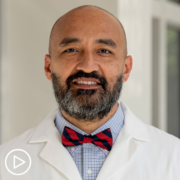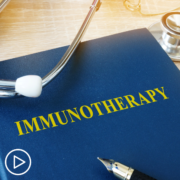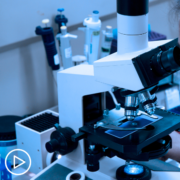Thriving with Myeloma: What You Should Know About Care and Treatment from Patient Empowerment Network on Vimeo.
What does it mean to thrive with myeloma? Myeloma specialist and researcher, Dr. Joshua Richter discusses the goals of myeloma care, reviews treatment options –including research updates – and shares tools for taking an active role in decisions.
Dr. Joshua Richter is director of Multiple Myeloma at the Blavatnik Family – Chelsea Medical Center at Mount Sinai. He also serves as Assistant Professor of Medicine in The Tisch Cancer Institute, Division of Hematology and Medical Oncology. Learn more about Dr. Richter, here.
Download Guide
See More from Thrive Myeloma
Related Programs:
Transcript:
Katherine:
Hello, and welcome. I’m Katherine Banwell, your host for today’s program. Today’s webinar is about how to live and thrive with myeloma. We’re going to discuss myeloma treatment goals and how you can play an active role in your care. Before we meet our guest, let’s review a few important details. Before we get into the discussion, please remember that this program is not a substitute for seeking medical advice. Please refer to your healthcare team about what might be best for you. Let’s meet our guest today. Joining me is Dr. Joshua Richter. Dr. Richter, welcome. Would you please introduce yourself?
Dr. Richter:
Hi. Thank you for having me today. My name is Joshua Richter.
I’m an associate professor of medicine at the Tisch Cancer Institute Icahn School of Medicine at Mount Sinai and the director of myeloma at the Blavatnik Family Chelsea Medical Center of Mount Sinai.
Katherine:
Great. Thank you for taking the time to join us today. There were two major cancer meetings recently, ASCO and EHA. Are there research updates from those meetings that myeloma patients should know about?
Dr. Richter:
Absolutely. These are some of the biggest meetings that we have every year that attract all types of people, patients, caregivers, physicians, nurses, Pharma, even investors from all over the world. We’re coming off of the back-to-back American Society of Clinical Oncology and European Hematology Association meetings, and there were a couple of really important updates and data. One of them at ASCO actually had what we call a plenary session.
A plenary is the top type of session at any one of these congresses, and it was around something called the DETERMINATION trial which looked at something a lot of patients may be familiar with, the notion of getting VRd, Velcade, Revlimid, and dexamethasone, with or without getting a stem cell transplant as part of their initial treatment. Now, many years ago when our initial therapy was not so good, we showed that transplant was better than what was good 30 years ago.
But, we have better treatments now. So, do we still need high-dose chemotherapy and stem cell transplant?
And what was really interesting about this data set is that if you do get a transplant upfront, you do seem to have a longer PFS, progression-free survival, meaning you stay in remission longer if you get your transplant as part of your initial therapy. However, there was no difference in overall survival, meaning how long you actually lived. And this may not make a lot of sense at first, but think about patient one who stays in remission longer, but because now their disease is a little more refractory, the subsequent therapies don’t work as well as compared to the person who doesn’t get the transplant upfront.
And then those latter therapies work a little better, and when you add them all up, they come out about the same. So, I think one of the things that comes out of this is, “Do I need the transplant?” No, you don’t need the transplant as part of your initial therapy.
We’re still trying to figure out who really needs it and who doesn’t, but you can always never do it or save it for a later time. So, that was really one of the big things that came out of the ASCO meeting.
Katherine:
What about EHA?
Dr. Richter:
So, EHA had a lot of updates both in terms of CAR T-cell therapies and bispecific antibodies, and bispecific antibodies are near and dear to my heart. They’re my big passion in myeloma, and I had the honor of presenting updated data on the Regeneron 5458 bispecific antibody at EHA.
This is a BCMA CD3 bispecific. So, many people may be familiar with monoclonal antibodies like daratumumab, which is just an antibody that gets injected and attacks the cancer.
Bispecifics are molecules that are injected that have two arms. One grabs onto the cancer cell; the other grabs onto your own immune cells that we call T cells and activates them to attack the cancer. Very interesting new therapy.
Very exciting, and very high response rates in people who have had tons and tons of treatment. So, in people that have seen almost everything in the highest dosing group of the study, 75 percent of people responded, which is very, very high.
But more notably, the big side effect we look out for called CRS or cytokine release syndrome, that’s where we activate your T cells and they get so activated they can cause other problems. That can be pretty high in some of our immune therapies, but in this drug, there’s only 38 percent, and all of this was relatively minor. It wasn’t the really big stuff.
So, the reason why this is so near and dear to my heart is that some of these therapies like CAR T have to be given in a major center that does transplants.
But bispecific antibodies, if put together the right way, can be given in your local hematologist’s, oncologist’s office. So, a lot of great potential long-term get everybody treated with these drugs. And then, one or two other little things that I thought were really huge, one was the combining of bispecific antibodies. Studies called the TRIM protocols combined two different bispecific antibodies, one called teclistamab, and one called told talquetamab. Each got combined with daratumumab.
So, not only are we already seeing just the bispecific by itself, we’re starting to combine it and seeing unbelievable response rates. That was updated at EHA, which was groundbreaking. And then in CAR Ts, two things really caught my mind. One was the CARTITUDE-2 data basically giving CAR Ts earlier on to patients had a 100 percent response rate. Can’t really do better than 100 percent. So, it’s not just about getting 100 percent of people in remission.
It’s keeping them there and curing them, and it starts by getting 100 percent of people to respond. So, really looking forward to see how this develops.
But one of the other things was another CAR T that’s coming out of China that targets two different things. It targets BCMA and CD19, both of which can be found on myeloma cells, although CD19 is actually on the myeloma stem cell. It’s a little kooky. But one of the big issues with CAR Ts is manufacturing time. Right now, it takes four to eight weeks to make them. But in this construct, they were able to make them, it took them between 22 and 36 hours. So, for many people, they were able to manufacture the CAR Ts, theoretically, for patients within one day.
So, if we can not only get this therapy to work but shrink the manufacturing from a month or two to a day or two, that would make this more accessible to more patients, get them to their treatment on time. So, the sky’s the limit with our immune options right now.
Katherine:
Excellent. Since this webinar is part of Patient Empowerment Network’s Thrive series, I thought we could start by getting your opinion on what you think it means to thrive with myeloma.
Dr. Richter:
Absolutely. And I love that term. I recently chaired a 5K walk for the MMRF, and the word that is thrown around a lot in cancer is “survivorship.” And, I got up there and I said, “That’s not a word I like to use. I like to use the word “thrivorship.” So, I love that you’re using this word because to me, surviving is an important part of dealing with cancer, but it’s the first step. Thriving is the goal. The goal is not to just get through it. It’s to go beyond it. It’s to do everything you want to do in life: personal, family, business, anything you want.
If you want to spend your time fishing, if you want to spend your time skydiving, if you want to spend time with your grandkids, and enjoying that time, and as much as humanly possible, keeping the notion of cancer way out of your brain. To me, that is thriving and not just surviving with a diagnosis like myeloma.
Katherine:
That helps us guide through the conversation as we continue on. Getting the appropriate myeloma care is, of course, part of thriving. So, let’s talk about treatment. How would you define treatment goals?
Dr. Richter:
Sure. So, treatment goals are different for each different individual because unfortunately, myeloma tends to affect people who are older. So, whereas the goals for an 85 or 90-year-old diagnosed with the disease is maybe things like, “I don’t want to suffer. I don’t want to have as many side effects,” but the goal is not to live 40 years, that’s different from a 40-year-old who may say, “I’m willing to tolerate certain side effects because I want to live as far as possible.” So, in reality, there always has to be this huge balance. And as with anything in medicine, an open dialogue with your care team is crucial to understand what your goals are because a lot of us make assumptions on both sides.
The patient may assume that we want certain things out of this. We may assume the patient wants certain goals. Really open, vibrant discussions where there are no taboos, there’s nothing wrong to say. I’ve had patients say, “I don’t care what happens. My granddaughter is getting married next year. I need to be there.
Anything beyond that, I don’t care.” That’s their goal. They’re entitled to their goal. I will work with them within that construct. So, really being open about what the goals are. Right now, what I tell patients is, especially for younger patients who if you’re already 85 or 90, you’re getting closer and closer to how long you’re likely to survive even without myeloma.
It’s kind of hard to have a 90-year-old have a 30-year survival. We’re not living to 120 just yet anyway. But for most of my patients, I say my goal is to either keep you in remission so long that you pass from something else many years from now, or to keep you moving until we have a cure that we can just give you and then make sure that that cure, that you’re able to accept it. That your body’s intact, your bone marrow’s contact, and this is something we can provide for you.
Katherine:
Well, tell me what you think the patient’s role is, then, in setting care goals.
Dr. Richter:
Absolutely. The patient has the most crucial role of course. And, one of the things is honesty and really being to a point of brutal honesty with how they’re doing. I always tell patients, “You don’t get extra points for suffering. It’s not that if you sit there in pain you’re going to do better. Let me know what type of pain you’re having.” And pain doesn’t just mean a bone is hurting, or a muscle’s hurting, we call somatic pain.
There can be neuropathic pain where the nerves hurt.
There can be emotional and spiritual pain. These things all need to be addressed. And if you are suffering in silence, we have a lot of tools nowadays not just medicines. We have people to talk to. We have resources. So, letting us in to help is one of the most crucial things because we’ve actually shown that if you actually improve some of these, you may actually improve overall outcomes. So, the patient, please, all we want to do on the care side of the equation is help.
Let us know what’s bothering you. It may be small to you, it may be big to us, or vice versa, but the more open you are, the better we can help.
Katherine:
Yeah, that’s great advice. Before we move on to discussing how the treatment choice is determined, let’s define a couple of terms that are often mentioned in myeloma care. What does it mean to be refractory and how is that different from relapsing?
Dr. Richter:
Great question. So, these terms have very specific definitions in myeloma. “Relapsing” just means that the disease is coming back. So, you had myeloma that was measurable, you went into a remission, and now it is showing signs that it’s coming back. We call that “relapsing.” And depending upon what type of myeloma, we have specific definitions. So, if you’re IgG kappa and you make an M-spike, if your M-spike goes up at least 0.5 and at least 25 percent, we call that “relapsing.” If you’re a light chain, it’s gotta go up by at least 100. But, you’ve gotta make sure the units are right.
“Refractory” means that you either did not respond or you’re progressing on or within 60 days of your last treatment. So, I put you on Revlimid maintenance, and you’re on Revlimid, and your disease gets worse. You are now relapsed and refractory to Revlimid. If I give you a transplant and then I put you on nothing, and two years later your disease comes back, you’re relapsed but not refractory.
Katherine:
What I would like to look at is because everyone’s different, what’s going to work for one patient might not work for another. So, how do you choose which treatment is right for a patient?
Dr. Richter:
Really great question. So, unfortunately, myeloma, we don’t have the granularity just yet to say exactly what’s going to work for everyone. Our goal is to kind of be what I like to think of as urinary tract infections. You have a UTI, you pee on a dish, we put little discs of antibiotics and a couple of days later, we’re like, “You have an E. coli and Cipro will work.” You get the Cipro and it goes way. We don’t really have that outside of a few drugs. We do know that the drug venetoclax works really well in people who have a very specific type of translocation in their myeloma cells, something we call translocation (11;14).
But for the most part, we don’t know, and we have lots of options and we decide what drugs to use based on three factors: disease-related factors, treatment-related factors, patient-related factors. So, patient-related factors. Are you older or younger? Fit or frail? Do you have comorbidities? If you have a lot of neuropathy from diabetes, I don’t want to give you a drug that’s going to cause more neuropathy. If you have a lot of cardiac issues, I’m not going to give you a cardiac drug. Disease-related factors. Is your disease growing fast or slow? Can I give you some pills or do I need to give you intravenous immediately to stop it? Is it pressing on a nerve? Do I need to add radiation?
So, those are some of the big factors. And then, treatment related factors. Have you had certain other drugs? So, if you’re refractory to Revlimid, I may not want to give you Revlimid again. If you have a lot of side effects or didn’t respond well to Revlimid, I may not want to use another drug similar to Revlimid like Pomalyst.
I may want to choose another class. So, that’s kind of putting all of that together to come up with a treatment choice because there’s no clear guideline.
Katherine:
Right. Can you help us understand some of the common issues that myeloma patients experience and how they might be managed?
Dr. Richter:
Sure. So, fatigue is an absolutely huge one. And fatigue can come from a lot of different things. One, fatigue can come from other medicines. A lot of patients have cardiac issues and may be on other medicines causing fatigue. So, optimizing your other clinical status is important. Anemia can lead to fatigue, so we monitor your blood counts very closely, and if they drop, can we provide medicines to boost them up? Drugs. Some of the therapies we have can cause fatigue, and one of the biggest ones is Revlimid.
And, I tell people what actually tends to help is you take the Revlimid at night instead of the morning because if you take it at night, it tends to maximize the fatigue while you’re already sleeping. If you take it in the morning, it tends to maximize at that horrible, coffee-needing hour of 3:00 p.m. to 4:00 p.m., or 4:00 p.m. to 5:00 p.m. where you’re like, “Oh, I’ve gotta lie down.” So, fatigue is a really big one. Neuropathy. Neuropathy is really getting less and less in our new patients because more of our modern drugs don’t cause it, but unfortunately, some patients still have neuropathy and they may be using drugs like gabapentin or Lyrica.
There’s some other really old drugs and new drugs that can help. Drugs like Pamelor, which is nortriptyline, or Cymbalta may help quite a bit, or another drug called Effexor. And, many of these drugs may be used for
anxiety and depression, but also work for neuropathy. And then, even going to things like the cannabinoids; things like marijuana derivatives may actually be able to help both in salves or even edibles may actually help some of the neuropathy issues. And then, we get into some kind of out there stuff like compounding ketamine to help with some of these salves or oral combinations. So again, a little bit of neuropathy, let us know because there may be some ways to help.
Katherine:
Are kidneys impacted by any of the medications that patients take?
Dr. Richter:
So, kidneys are an excruciatingly important part of myeloma, and d in my mind, one of the keys to long-term survival and outcome. So, there are three things that I tell all of my patients to help preserve long-term kidney health. Two of them are easy to wrap the head around. One is a little bit harder. Number one, keep yourself well hydrated. The kidneys are like a filter. Think, like, the filter for your car. If you drove 100,000 miles in the desert and didn’t change your oil, there’d be problems. So, especially now that there’s warmer weather, by the time you already feel yourself dehydrated, you’re about 10 to 15 percent low on the total amount of body water you need.
So, especially if you’re going out there doing yard work, playing with the kids or grandkids, make sure you’re drinking plenty of water. Two, avoid NSAIDs. Drugs like Aleve, or naproxen, or Advil, or ibuprofen can be harmful to the kidneys. So again, please discuss with your care team. There may be better alternatives to treat your pain without hurting the kidneys. And the third is when all else possible, and avoid intravenous contrasts for CAT scans. Now, the IV contrast you get for MRIs is called gadolinium. It’s not harmful to the kidneys. But, the contrast for CAT scans is iodine-based, and although the newer formulations are better, it can still hurt the kidneys.
So, my advice is the following. If you’re in the ER at 2:00 a.m. in the morning and they want to do an urgent CAT scan with IV contrast, let them do it. It’s likely not going to be an issue. If you go to see an orthopedist and they say, “I want to get a better look at that leg that’s bothering you. I’m going to get a CAT scan with IV contrast,” tell them to call me. We’ll find an alternative.
Katherine:
Okay. All right. Good advice. Thank you. So, once treatment has begun, how do you know if it’s working?
Dr. Richter:
Absolutely. So, the majority of myeloma patients are what we call “secretory.” And by “secretory,” it means that the cancer cells secrete a protein that we can measure in the blood either an M-spike, which is an intact immunoglobulin like IgG and kappa, or a free light chain. It doesn’t make that IgG part, just a free kappa or free lambda. And basically, when these protein levels go up, we know the cancer cells are growing. When these go down, we know we’re killing the cancer cells. And we actually call your remission based on how much we lower it.
If we lower it 25 to 49 percent, that’s an MR or minor response, or minor remission. 50 to 89 percent is a PR, partial response, partial remission. 90 to 99 percent is a VGPR, a very good partial remission, and then all gone in the blood and then we do a bone marrow is a CR or complete remission.
For some people, their disease can be non-secretory where the cancer cells don’t make that protein anymore.
And for those people, we need to do regular imaging to see if they have growths of myeloma we call plasmacytomas, or unfortunately, we need to do regular bone marrow biopsies to see how much of the bad cells are growing inside the marrow.
Katherine:
All right. How do you know when it’s time to switch treatment?
Dr. Richter:
So, in general, when patients fulfill the criteria for what we call “progressive disease” or PD, that’s the time to change, or intolerance that regardless of how we dose adjust, dose hold or add supportive care, it’s not tolerable for a patient to continue.
Intolerance is a very personal thing. There are things that certain people are willing to tolerate and others not. So, we try to adjust that. Just like we have criteria for response, PR, VGPR, we have criteria for progression. And in general, it’s a 25 percent increase from your baseline and 0.5 increase in your M-spike or 100 increase in your light chains. So, when the disease numbers are going up, we tend to switch.
Now, people may say, “But I feel fine,” and a lot of this is because you’re diagnosed with an amount of disease up here. We get you in remission, you’re down here. And once you go like this, we can see the writing on the wall and we’d rather be proactive than reactive. So, instead of waiting until the numbers get up here to cause trouble, once it goes from there to there, we intervene, change therapy to bring it back down.
Katherine:
Dr. Richter, why is it essential for patients to share any issues they may be having with their healthcare team?
Dr. Richter:
It is absolutely crucial because some things that may be very, very minor to them may be the tip of the iceberg of something very, very worrisome that we really need to investigate because sometimes, little problems are little now, and over time, they can become problems that we can’t so easily reverse. So, things like neuropathy, fatigue, or actually better yet, what I tell my patients is, “You know your body. If there is something out of the ordinary, big or small, let us know.”
And I would way rather a patient tell me 10 things in a row that mean nothing than not tell me about that one thing that means something.
So, for example, one of the disorders that’s associated with myeloma is called amyloidosis.
And when amyloid attacks the kidneys, you start to have protein in the urine, and this looks like bubbles, like foam in the urine. So, if someone has no foam when they urinate, and then over a period of months to years, they’re starting to notice lots of foam, tell me because that means we may need to look for things like amyloid. So, really any time something changes.
Katherine:
Anything. Yeah. I want to make sure that we get to some of the audience questions. So, let’s start with this one. PEN community member Sal sent in this question prior to the program. “What is the difference between myeloma and multiple myeloma?”
Dr. Richter:
A really great question. For the most part, the terms are synonymous. We abbreviate multiple myeloma as myeloma. But along those lines, and I literally saw a patient today who said, “Why is it called multiple myeloma?” Well, when you have a group of bad plasma cells that forms a tumor, we call that a plasmacytoma, “cytoma” meaning “bad cells,” and “plasma” because they’re plasma cells. And when you have one of them, it is a solitary plasmacytoma. Once you have two of them, it’s multiple myeloma because it’s in multiple spots in the marrow or multiple spots in the body. So, for our purposes, we use them interchangeably, but that’s where the “multiple” comes from.
Katherine:
Okay. Isaac sent us this question. How long does the average myeloma patient remain on Revlimid? And, is there a suggested time period?
Dr. Richter:
Really great question. It depends upon the setting we’re looking at, and for the most part, a lot of people are probably asking about the maintenance setting. So, after initial therapy or after transplant, we put you on Revlimid. How long do we keep you on? The American adage has always been, “More is better,” so as long as you tolerate it and as long as it works. Outside of the U.S., they’ve done a couple of studies looking at one year and then stopping, or two years and then stopping.
And in a big trial that got presented a year or so ago, they compared the two years then stopping versus just staying on, and the people who just stay on do better.
So, now the current thinking is just keep you on long-term. What’s going to change that in the long term is we’re starting to use a technology called MRD, minimal residual disease, so, doing a marrow and trying to find one in a million or one in 10 million cancer cells.
And then, there’s something called sustained MRD meaning if you do two MRD analyses at least 12 months apart and they’re both negative, we call that sustained MRD negative.
And, there’s a hint that some people on maintenance Revlimid who have sustained their MRD negativity, they may do just as well stopping versus staying on it. We don’t know exactly who that is yet, but that’s going to be better understood in the next few years.
Katherine:
Okay. Randall writes, “I was diagnosed last year with myeloma, and my first treatment worked, but now I’ve relapsed. Is it too late to consider a second opinion or a consult with a specialist? Would that change anything?
Dr. Richter:
It’s a phenomenal question. There have actually been studies to show that if you engage with a myeloma center at least once within your myeloma journey, you do better than someone who has never done that. So, it is never a bad time to seek out a specialist. And one of the good things that came out of COVID is telemedicine. So, if there’s not someone right in your area, reaching out to some of our advocacy groups to help connect you to physicians like me or any of my colleagues, we’re more than happy to see anyone, I’ll see you with an MGUS that’ll never bother you, as will all of my colleagues and people who work in myeloma.
If you’ve had one prior line, 15 prior lines, anywhere in between. So, I think it’s always a good idea to see a specialist because he or she is more than happy to work with your local doctor to optimize your treatment without having to necessarily go to another center.
Katherine:
Yeah. Well, thank you for all of that, Dr. Richter. And, please continue to send in your questions to question@powerfulpatients.org and we’ll work to get them answered on future programs. So, Dr. Richter, we’ve talked a lot about why patients should play a role in their care.
What advice do you have for patients to help them feel confident in speaking up and becoming a partner in their care?
Dr. Richter: So, that’s not always easy for a lot of people to do, and for some people, no problem. They’ll speak up at the first sign of anything. One bit of advice I would give to people who may have concerns or may not feel as comfortable about doing this is first of all, there’s a lot of members of the care team. So, I have patients that may not want to mention it to me, but mention it to my nurse or the medical assistant, and we all talk. So, that’s one way.
The other thing that I think may help is involvement in patient support groups, hearing what others have to say about similar experiences and learning from them, them learning from you, and that may actually give you more of a confidence to speak with your care team. But, the advocacy groups like the MMRF and IMF have tons of local support groups where you can sit in, and specialists come and speak or people share stories. And I think that can be really helpful to figuring out your optimal journey.
Katherine:
And knowing that you’re not alone –
Dr. Richter:
Absolutely.
Katherine:
– in how you’re feeling. As we close out this conversation, I wanted to get your take on the future of myeloma. What makes you hopeful?
Dr. Richter:
So, we’ve had what we call Gestalt switches in myeloma. And what I mean by that is let’s rewind decades ago. We gave chemotherapy. Chemotherapy was designed to kill any cell that divides rapidly because that’s what cancer cells like to do.
It kills the good and the bad. It makes your hair fall out, throw up, horrible stuff. It doesn’t work too well. Then about 20 years ago, we started this switch to the novel therapies, Revlimid, thalidomide, Velcade, and then a decade later, daratumumab. And now, we’re having targeted agents which spend more time targeting the bad stuff, less time doing off-target stuff, really ramping things up.
We are at the precipice of a brand-new Gestalt switch in myeloma.
The immune world. The immune therapies. And right now, T-cell redirection therapy is what we call it either with CAR Ts, where we take your T cells out, engineer them, and put them back into your body all revved up, or we give you an off-the-shelf, bispecific that grabs onto your cancer and your T cell and, brace yourself, we even have trispecifics, which can engage your myeloma, another cell in your body, and yet another cell.
If you go on clinicaltrials.gov, which lists all the trials for everything, every disease, there are over 3,000 active trials in myeloma.
And what I tell people is when I first started and I sat across from a patient, I would say, “I’m really sorry. It’s not curable.” And now I say, “We are curing some people today by accident.” But over the next period of time, we’re going to do this deliberately and more frequently. And the goal is and always has been 100 percent of cure for 100 percent of patients, 100 percent of the time.
And, I kind of feel right now we’re almost like that 2001: A Space Odyssey when the obelisk lands. We have these immune therapies. We know they’re great. How do we combine them? How do we use them? How do we take all these great tools and turn it into a cure for everyone?”
And with so many great partners between advocacy groups and Pharma and patients and cancer centers, we’re going to collaborate and we’re going to start getting those answers in my lifetime, and I could not be more excited about that.
Katherine:
Oh, I bet. I bet. It seems like there’s been so much progress and hope in the field. Dr. Richter, thank you so much for joining us today. It’s been a pleasure.
Dr. Richter:
Thank you so much for having me. I’d love to come back anytime.
Katherine:
And thank you to all of our partners. To learn more about myeloma and to access tools to help you become a proactive patient, visit powerfulpatients.org. I’m Katherine Banwell. Thanks for joining us.






























